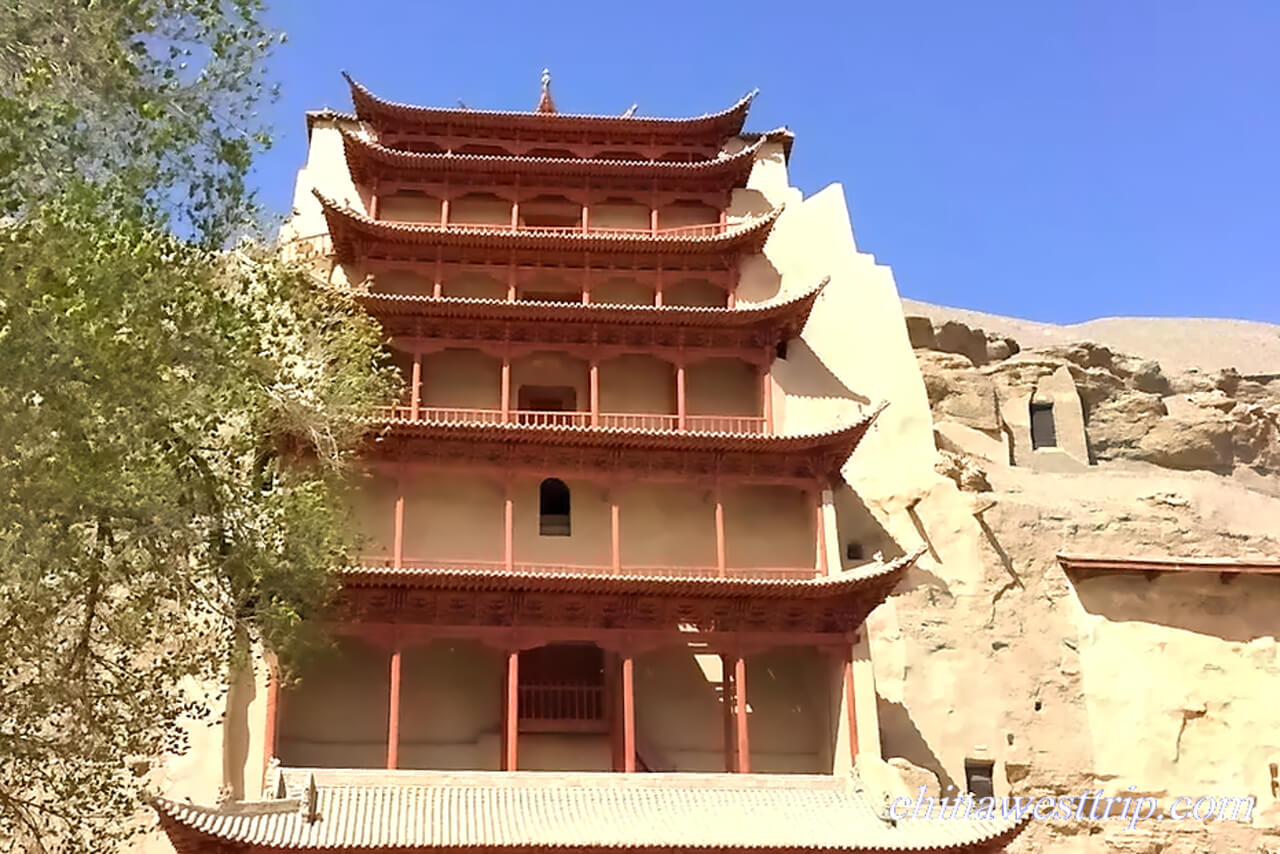
Dunhuang Mogao Grottoes
Name in Chinese: 莫高窟 Mò Gāo Kū [mɔ:gauku:]
Duration of Tour: Three Hours
Location: Dunhuang County, Gansu Province
Highlights: Carving Art, Mural Paintings and Buddhist Culture
Reputations: the oriental Louvre, a World Cultural Heritage Site, a National Key Historical and Cultural Relic Site under Protection
Well-known as the oriental Louvre, Mogao Grottoes are a treasure trove of artworks and antiques. The assemblage of statues and murals has revealed the history of the Silk Road and Chinese Buddhism. It is also known as the Thousand-Buddha Grottoes. There are totally 735 grottoes at the site. Painted carvings and murals can be found in 492 of the grottoes. The number of sculptures is 2,415. The mural paintings measure about 45,000 square meters(53,820 sq.yd). Since Duhuang served as a revolving-door of the cultural exchanges between China and the western countries, the statues and murals feature the combined aesthetics.
The carving project began in the Sixteen-state Period(304-439) and lasted for almost 1,000 years. The Sixteen-state Period refers to a hundred-year civil war in Northern China. In the year of 316, the Western Jin Dynasty was overthrown and the country was torn apart by both strife and invasion. Southern China was controlled by the Eastern Jin Kingdom, while Northern China descended into chaos. At that time, there were many warlords in Northern China. Most of their ancestors were nomads migrated to Northern China along the silk road. The warlords each occupied a certain part of the country and established their own monarchies. The Former Qin State(351-394) was the strongest one of the powers. Most of the warriors believed in Buddha. By the support of the warriors, Buddhism began to spread widely in North China. The first maker of Mogao Grottoes was Master Yue-Zun, a monk from the Former Qin State, who went on a pilgrimage to the west. It was in the year of 366 that the monk saw a spectacular view of Buddhist halo at Mingsha Mountain, when he was in Dunhuang. The monk thought that the mountain must be a holy place where Buddhas revealed themselves. Then, he was determined to stay in the mountain to make grottoes with Buddha’s images. In the following centuries, more and more Buddhists went to Dunhuang for making grottoes. They hired many skilled masons, carpenters and painters from different regions of China. At the same time, divers cultures were also brought to Dunhuang by traders from the western countries. The Tang Dynasty(618-907) was the peak period of making grottoes. The carving project stopped after the Yuan Dynasty was founded(1271-1368).
The assemblage of Mogao Grottoes was designated as a national historical and cultural relic site under protection by Chinese government in 1961, and was added to the list of world cultural heritage site by UNESCO in 1987. Nowadays, it has become one of the must-see attractions in Northwestern China.
The admission charges to the grottoes also include the access to the Digital Exhibition Centre where visitors can watch two movies. The first movie explains the history of the site and the second one is an impressive 3D movie unveiling the mystery of some grottoes at the site which are still off limits to the general public. Both the movies are about 20 minutes in length.
How to Get to Dunhuang Mogao Grottoes
The site of the grottoes is located 25 kilometers(15.5 miles) to the southeast of downtown Dunhuang. Dunhuang is a county in Northwestern Gansu Province. The distance between Dunhuang and Lanzhou is about 1,100 kilometers(683 miles). There is an airport in Dunhuang. But the airport is quite small, operating only a few flights to some of domestic cities within Mainland China, such as, Beijing, Shanghai, Chengdu, Lanzhou, Xi’an and Urumqi. However, tourists prefer to start their journey along the silk road from Xi’an, travelling to Dunhuang by car and bullet train.
Travel Tips:
1. The sun’s ultraviolet rays are responsible for both tanning and burning. Please pack the suncream, sunglasses and sunhats for your Silk Road tour.
2. It is necessary to make a reservation minimum 7 days in advance for the visit to Mogao Grottoes in the peak season of Tourism. The peak season lasts from May to October each year.
Opening Hours:
8:00a.m.---6:00p.m.
Suggested Itineraires:
Related Articles:
Author: Tina Luo
Update:

Dunhuang Mogao Grottoes